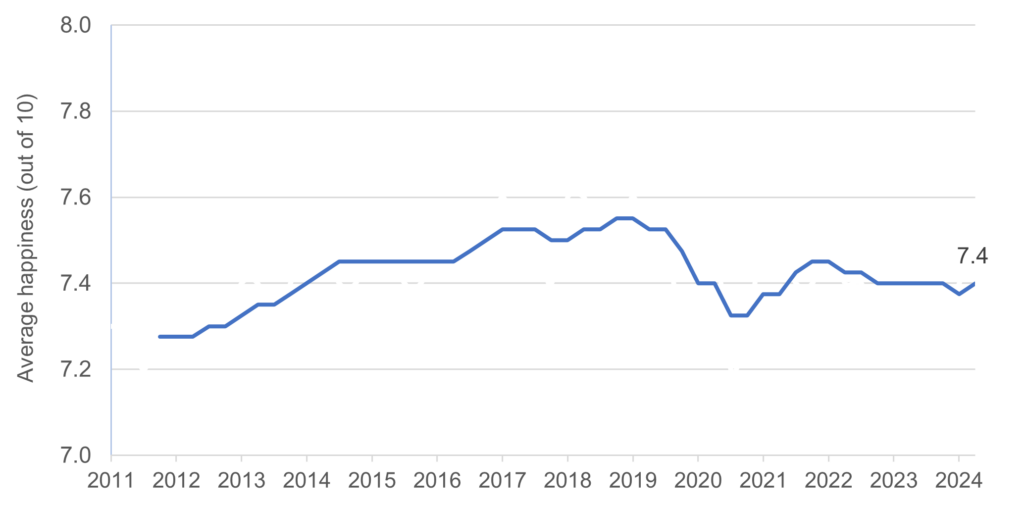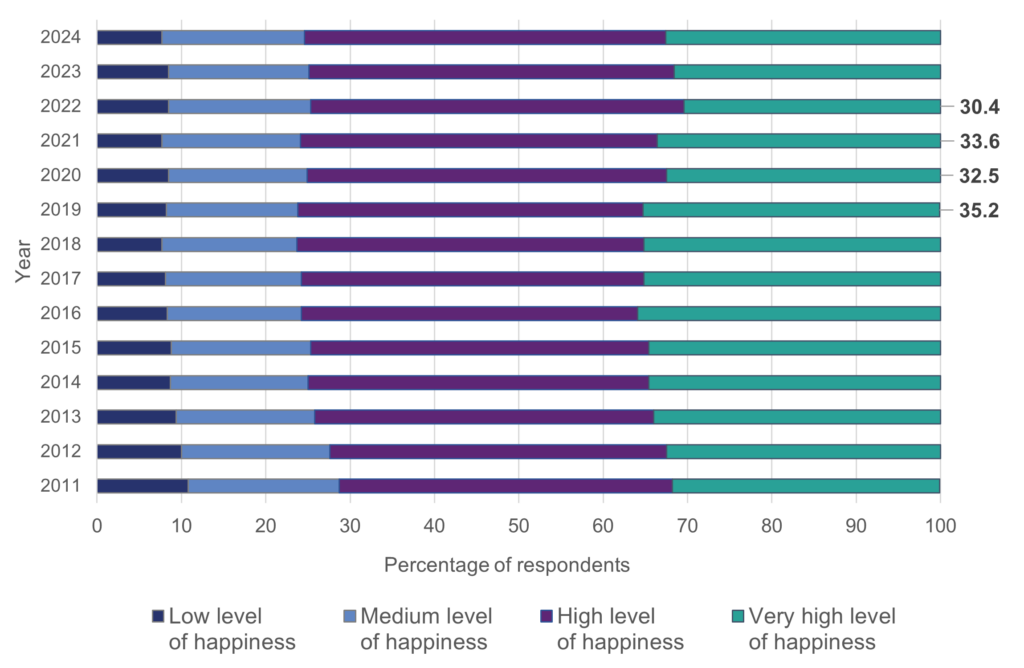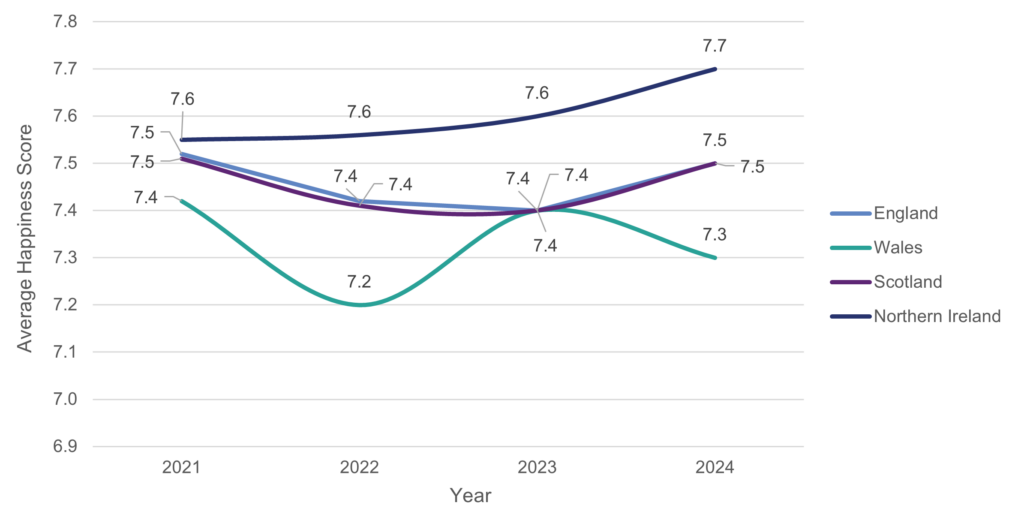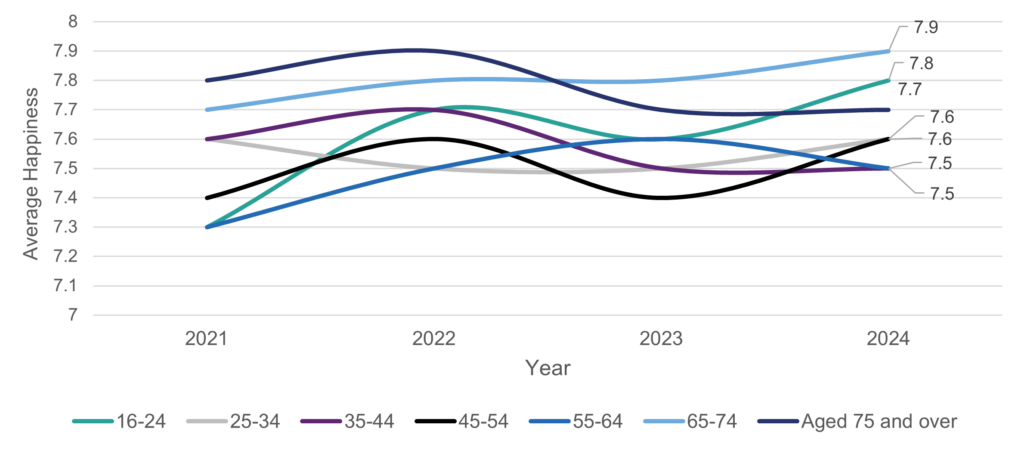Gross Domestic Product (GDP) provides an indication of the economic health of a country, but examining happiness can give a clearer picture of the experiences of people living with economic and environmental changes. To mark the UN’s International Day of Happiness, this blog article will discuss how happiness is measured, the levels of happiness across the UK and why Northern Ireland is (still) the UK’s happiest region.
Measuring happiness
Since 2011, the Office for National Statistics (ONS) has used four standardised measures of wellbeing to measure wellbeing levels in the UK. According to the ONS, ‘Personal wellbeing is the most direct representation of how people are doing‘. It is measured by asking questions about people’s satisfaction with their lives, their anxiety, whether they feel what they do in their lives is worthwhile and their happiness.[1]
The measures are self-descriptive, and they don’t make any assumptions on how people’s objective conditions (such as income) are affecting them. They just ask respondents to enter their own views on their wellbeing. So how happy is the UK as of 2024?
Happiness across the UK
Average UK happiness has fluctuated between 7.3 and 7.6 (out of 10) since 2011. As Figure 1 shows below, happiness steadily rose from 2011 to 2019, before declining in 2020/21, largely as a result of the COVID-19 pandemic.

For some context, the UK is 23rd in global happiness rankings, according to the World Happiness Report 2025. The UK has continued to fall in the rankings in recent years, being 20th in 2024 and 13th in 2019.
Figure 2 gives more detail about the average happiness. Respondents to the ONS Annual Population Survey are asked to rate, on a scale of 0-10, how ‘happy they felt yesterday’. Responses are broken down into low (0-4), medium (5-6), high (7-8) and very high (9-10).

Figure 2 shows that very high levels of happiness dipped in 2020 and in 2022, with corresponding increases in the high, medium and low levels of happiness. The World Happiness Report 2022 did note that 2022 was a ‘year of crises, including the continuing COVID-19 pandemic, war in Ukraine, worldwide inflation and a range of local and global climate emergencies’. Therefore a range of factors likely contributed to the dip in happiness in 2022.
Happiness in Northern Ireland
Looking at average happiness scores across each of the four UK nations presents an interesting picture. Since 2021, Northern Ireland has consistently scored higher than England, Scotland and Wales. Figure 3 shows that Northern Ireland’s average happiness score has increased steadily since 2021, placing it ahead of England and Scotland. Besides 2023, Wales has had the lowest average happiness.

Figure 4 breaks down the figures from Northern Ireland, showing that the percentage of respondents who reported feeling very happy has increased from 34% in 2023, to 38.7% in 2024. There were marginal increases in medium and low levels of happiness. However, compared to the other UK regions, Northern Ireland has shown higher percentages of respondents reporting that they felt very happy (for example, 32.5% of respondents in England felt very happy in 2024).

The Executive Office publishes a further breakdown of the data for Northern Ireland in its Report. The data showed that from 2020 to 2024, there was very little difference in the average level of happiness between males and females. The average happiness of both groups tended to be between 7.4 and 7.7 (out of 10).
Figure 5 examines the differences in average happiness between age groups in Northern Ireland[2]. From 2021 to 2024, average happiness for all ages ranged from 7.3 to 7.9. Older generations in Northern Ireland have tended to be the happiest, however the average happiness of 16-24-year olds has risen dramatically from 7.3 in 2021 to 8.8 in 2024. 55-64-year olds have consistently been the least happy age group.

Based on statistics, it might seem surprising that Northern Ireland is the happiest region in the UK. A 2024 report from Carnegie UK and Ipsos, Life in the UK 2024: Northern Ireland, reported that life in Northern Ireland was one of ‘stagnant wellbeing’, with issues including recent political instability, lower levels of investment and productivity, and higher levels of socio-economic deprivation compared to the rest of the UK.
In 2022, the Local Government Information Unit (LGIU) looked at some of the drivers that could explain why Northern Ireland is consistently the UK’s happiest region. Possible drivers included:
- Ongoing dividends from the peace process, where life is better ‘compared with 15 years ago’. However, the research was quick to point out that there is no clear correlation between the peace process and happiness, given the regions ongoing political challenges.
- Social capital: religion, family and community-based activities provide strong networks for interaction in Northern Ireland.
- Comparative similarities with the Republic of Ireland. However, while the Republic of Ireland has clear socio-economic drivers that could explain happiness, these drivers are less clear in Northern Ireland.
- Methodological issues. Finally, the research found that there could be broader methodological issues with the indicators used, as wellbeing (and happiness) is fundamentally ‘personal and subjective’.
So why is this important?
Measuring wellbeing and happiness is an important metric to determine whether changes in wellbeing ‘have resulted from government policies, actions and institutional arrangements’. It is important that we understand what actions can be taken when effectively utilising our resources to improve the health, wellbeing and happiness of our society. And while Northern Ireland might be the happiest place in the UK, we cannot lose sight of the systemic and ingrained issues negatively impacting people here every day.
To monitor and improve wellbeing across Northern Ireland, the Executive has developed the Programme for Government (PfG) Wellbeing Framework. The Framework has ten strategic domains of wellbeing, including: thriving children; cleaner environment; equal society; healthier lives; brighter futures; stronger economy; safer communities; caring society; better homes and living peacefully. The Executive intends to use the framework to understand which domains are improving, staying the same or getting worse. This data will be used to inform future PfGs.
To finish on a high point, to mark the International Day of Happiness, the BBC reported from Belfast that ‘people in towns and cities that would return a lost wallet, are the cheeriest places’. Needless to say, Belfast performed very well in this experiment.
___________________________
[1] Franklin. J et al. Mind, body, and connection. Low wellbeing in the UK (2024). Pro Bono Economics. P12
[2] Age bands changed between 2020-2021. Therefore, for consistency, data from 2021 onwards has been used.


